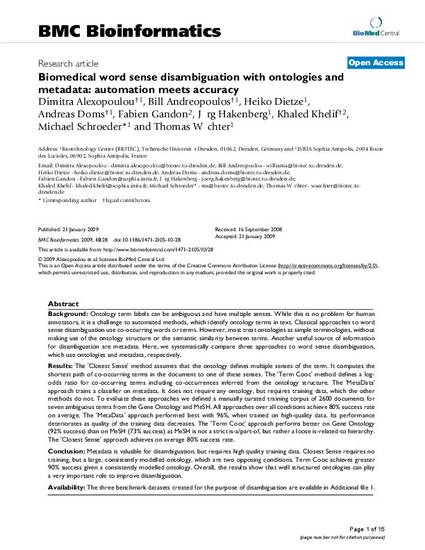
Article
Biomedical Word Sense Disambiguation With Ontologies And Metadata: Automation Meets Accuracy
BMC Bioinformatics
(2009)
Abstract
Background
Ontology term labels can be ambiguous and have multiple senses. While this is no problem for human annotators, it is a challenge to automated methods, which identify ontology terms in text. Classical approaches to word sense disambiguation use co-occurring words or terms. However, most treat ontologies as simple terminologies, without making use of the ontology structure or the semantic similarity between terms. Another useful source of information for disambiguation are metadata. Here, we systematically compare three approaches to word sense disambiguation, which use ontologies and metadata, respectively.
Results
The 'Closest Sense' method assumes that the ontology defines multiple senses of the term. It computes the shortest path of co-occurring terms in the document to one of these senses. The 'Term Cooc' method defines a log-odds ratio for co-occurring terms including co-occurrences inferred from the ontology structure. The 'MetaData' approach trains a classifier on metadata. It does not require any ontology, but requires training data, which the other methods do not. To evaluate these approaches we defined a manually curated training corpus of 2600 documents for seven ambiguous terms from the Gene Ontology and MeSH. All approaches over all conditions achieve 80% success rate on average. The 'MetaData' approach performed best with 96%, when trained on high-quality data. Its performance deteriorates as quality of the training data decreases. The 'Term Cooc' approach performs better on Gene Ontology (92% success) than on MeSH (73% success) as MeSH is not a strict is-a/part-of, but rather a loose is-related-to hierarchy. The 'Closest Sense' approach achieves on average 80% success rate.
Conclusion
Metadata is valuable for disambiguation, but requires high quality training data. Closest Sense requires no training, but a large, consistently modelled ontology, which are two opposing conditions. Term Cooc achieves greater 90% success given a consistently modelled ontology. Overall, the results show that well structured ontologies can play a very important role to improve disambiguation.
Disciplines
Publication Date
January 21, 2009
DOI
10.1186/1471-2105-10-28
Publisher Statement
This article originally appeared in BMC Bioinformatics, Volume 10, Issue 28, 2009, published by BMC. Authors retain copyright. The article can also be found online by following this link: https://doi.org/10.1186/1471-2105-10-28
SJSU users: use the following link to login and access the article via SJSU databases.
Citation Information
Dimitra Alexopoulou, Bill Andreopoulos, Heiko Dietze, Andreas Doms, et al.. "Biomedical Word Sense Disambiguation With Ontologies And Metadata: Automation Meets Accuracy" BMC Bioinformatics Vol. 10 Iss. 28 (2009) Available at: http://works.bepress.com/william-andreopoulos/15/
